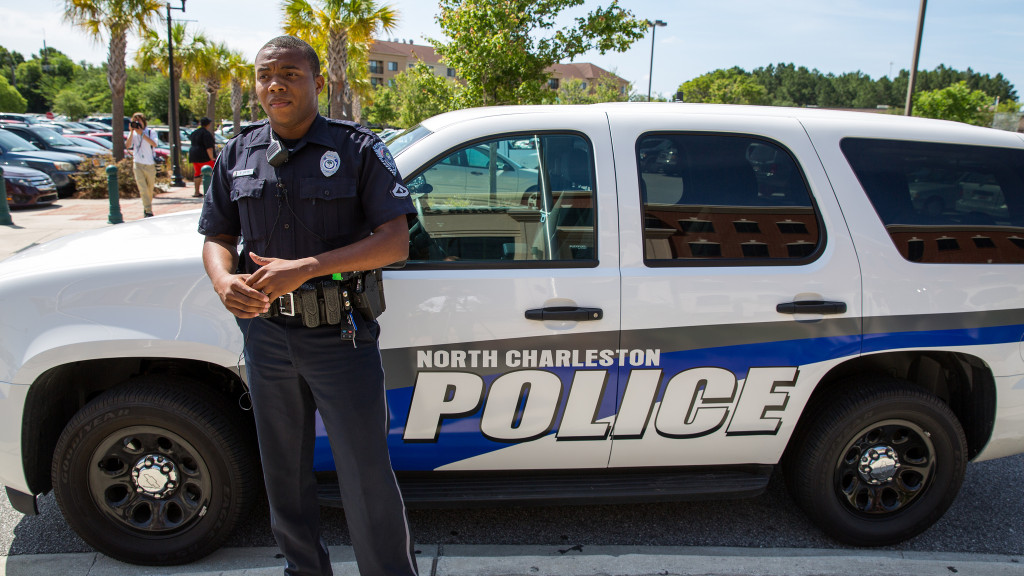
The death of Walter Scott shows that racism’s history is still present. (northcharleston / Flickr)
As protests developed and divided in the wake of Freddie Gray’s death—like they did for deaths of Michael Brown and Eric Garner among others—Walter Scott’s case looks like an anomaly. A point of rare consensus. On the same day that a video was released of police officer Michael Slager shooting an unarmed, fleeing Walter Scott (and framing him by means of taser thrown at his dying body), murder charges were applied, and the voices of the tepid boiled into decisive statements in the forefront, decrying the tragedy.
Why is the public response to the Walter Scott case different? This is a softer question than the question of why police violence keeps occurring, why victims have the same demographic profile, why what happened to Walter Scott has happened to many people like him. Yet a discourse has emerged, a slow and trickling realization has set in that this country is facing a deep problem, punctuated by too many names and cases with too similar details.
“What this mayor did is what we’ve asked mayors to do all over the country,” Al Sharpton said of Keith Summey, the white mayor of North Charleston, who took the stance that what occurred represented a systemic problem—the problem of accountability for police. Summer did as much as thank Feidin Santana, the citizen who took the video, “because it helped us to resolve exactly what did occur.” The exact event appeared on front pages of papers and nightly television news reports. It allowed for both a problem to appear and for its causes to appear pathologizable, abnormal, local. We were bearing witness to a bad officer. And thank goodness such a witness was available. New kinds of voices like Representative Mark Sanford, a white Republican, and Senator Tim Scott, a black Republican, both representing South Carolina, made their condemnation heard. A city mandate was given so that all officers will wear body cameras. Justice, or the sense of something like it, could be felt. Collective castigation bonded unlikely agreements.
“In the Deep South,” said Reverend Sharpton, “a mayor and police chief did what we couldn’t get mayors in the North and the Midwest to do.” The mayor and police chief delivered the basic vengeance of the law. The purgatorial black hole of grand juries was steered away from in the clarity of evidence. There is an irony in Reverend Sharpton’s statement, coming from within the first state to secede from the Union—a state that in 1915 spent 12 times more on education for white children than black children, a state famous for keeping Strom Thurmond and his pro-segregation views in office from 1954 until his death in 2003, a state with 164 lynchings of black men and women on record between 1877 and 1950 and not a single white person convicted for them. If expectations were already low for state officials and the justice system to confront its police killing problem, they are even lower in the South, where exceptions were the rule of law for decades. But somehow the tides that have favored non-indictment for police killings have turned, instead bringing swift murder charges.
The rumble underneath the statements by the mayor and police chief, the congressmen and state officials was the issue and the history of racism. At the funeral for Walter Scott, minister George Hamilton said to gathered mourners, “Walter’s death was motivated by racial discrimination. You’ve got to hate somebody to shoot them in the back.” This shift between discrimination in the general and locating it within the eyes and mind of Michael Slager, or anyone who perpetrates such actions, is a tricky ambiguity. On one hand, identifying that racist motives still arise and have some force within what some would say is a post-racial country is necessary. But, on the other hand, individualizing racist actions can allow actors to appear as vestiges of an ugly past; tainted buds that must be pruned in order not to spoil the bunch. When asked, North Charleston police chief Eddie Driggers admitted race might have been a factor in the shooting. Yet Dr. Hamilton, at the funeral service, where police officers and state officials were gathered with the family, said, “We will not indict the entire law enforcement for the act of one racist.”
“Perhaps the last socially acceptable form of bigotry left in America,” wrote one commenter in the National Review in 2013, is “bigotry against the South.” The article, “Guilty of Being Southern,” came after the Supreme Court’s Shelby County vs. Holder decision, stripping away key provisions of the Voting Rights Act of 1965. The majority opinion held that some provisions of the Act could be overturned, allowing nine states, mostly Southern, to alter their election standards without prior federal approval. These provisions had targeted areas that, at the time the act had passed in 1965, were especially prone to discrimination, and so deserving of the stronger sanctions to ensure equal access. The decision in 2013 effectively declared this work complete. Chief Justice John Roberts said these aspects of the Act were “based on 40-year-old facts having no logical relationship to the present day.” A law passed to provide protection for the long-delayed and thwarted equal voting promised by the 1870 Fifteenth Amendment was revised to now protect the leaders of historically-discriminatory states from the presumption of racism. “Congress–if it is to divide the states,” wrote Justice Roberts, “must identify those jurisdictions to be singled out on a basis that makes sense in light of current conditions. It cannot simply rely on the past.”
In a notable reliance on the past, Justice Roberts identified two sites of 1960s Southern civil rights uprisings to make the case that conditions today were incomparable to conditions in 1965. Selma, AL and Philadelphia, MS were pivotal locations for the decade’s civil rights movement. In Philadelphia, in 1964, three activists were murdered by the Ku Klux Klan, only discovered after national media attention pressured an FBI investigation to find their missing bodies 44 days later and uncovered a conspiracy including town leaders and Sheriff Lawrence Rainey. Ten men were eventually charged for the lynchings, although the number actually involved was likely many more. In Selma, state troopers and sheriff’s deputies halted the peaceful civil rights march led by John Lewis and Hosea Williams across the Edmund Pettus Bridge, attacking the marchers with tears gas, bullwhips, and batons. The televised coverage of these attacks impacted directly the subsequent passing of the Act. Justice Roberts, voicing the majority who cancelled the provisions of that act, said of Selma and Philadelphia that “Today, both of those towns are governed by African-American mayors,” proposing a theory that representation had been the problem all along.
Yet as a black man occupies the chief representative seat in the nation, young black men might be 21 times more likely to be shot by police than young white men (the government’s own puzzling lack of data on police killings prevents a broad perspective that could be agreed upon). Wealth inequality between whites and blacks has grown since Obama took office. In 2007, the median wealth of whites was 10 times that of black households, and in 2013 that ratio grew so that median white households had 12.9 times the wealth of median black households. It is likely, based on statistics as they are now, that one in three black men will face incarceration in his lifetime while, for white men, the likelihood is only one in 17. Representation has changed, but it is slow to create better conditions for black citizens.
One reason why the reaction to Walter Scott’s death was different might be that the public was already primed to read race and racism as forces in the South, and officials were likewise defensive about this perception. South Carolina cannot pretend a liberal, inclusive history like Maryland, New York, Ohio, or some parts of Missouri. The obverse of having a state that still defends flying the Confederate flag at its statehouse is that history is not so easily forgotten, and the wounds and bruises of the past lie just under the skin. Reconciliation has been a long, painful, continual process for Southern states—one that might never be finished, despite what five Supreme Court Justices contend. But as the Great Migration states in North and West find themselves awakened to their deep racist problems, the country must acknowledge its real history.
Isabel Wilkerson writes that “the North, with its shorter history of a mass black population, has only more recently dealt with the paradox of an enlightened ideal coexisting with racial disparity.” Last year, Ta-Nehisi Coates documented racist housing policies in Chicago in the mid-twentieth century that ravaged black wealth and created segregation of another kind. Coates writes, “All of our solutions to the great problems of health care, education, housing, and economic inequality are troubled by what must go unspoken.”
In 2007, Charleston opened the Old Slave Mart Museum, an exhibition on the state’s role in the slave trade that displays in naked tones the grotesqueness of its own history. It appeared after a growing trend in state museums from the 1990s forward to speak about the truth of slavery. Although the relics of such painful history might be more difficult to document in non-South regions of the country–where they would be not slave quarters but discriminatory housing loans, for instance–they must be included within the story that we tell ourselves about our country if its ideals will obtain in actuality.
·
 Chris Robinson is a North Carolinian currently living in Brooklyn. He works in academic publishing by day, and holds a Master’s in English and Creative Writing from the University of Chicago.
Chris Robinson is a North Carolinian currently living in Brooklyn. He works in academic publishing by day, and holds a Master’s in English and Creative Writing from the University of Chicago.

